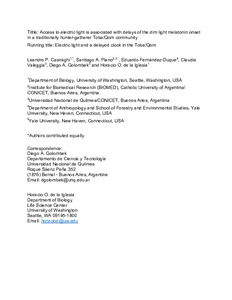Por favor, use este identificador para citar o enlazar este ítem:
https://repositorio.uca.edu.ar/handle/123456789/10856| Título: | Access to electric light is associated with delays of the dim light melatonin onset in a traditionally hunter-gatherer Toba/Qom community | Autor: | Casiraghi, Leandro P. Plano, Santiago Andrés Fernández-Duque, Eduardo Valeggia, Claudia Golombek, Diego A. Iglesia, Horacio O. de la |
Palabras clave: | MEDICINA; PUEBLOS ORIGINARIOS; SUEÑO; FISIOLOGIA; LUZ ARTIFICIAL; LUZ NATURAL | Fecha de publicación: | 2020 | Editorial: | Wiley | Cita: | Casiraghi, L. P. [el al.]. Access to electric light is associated with delays of the dim light melatonin onset in a traditionally hunter-gatherer Toba/Qom community [en línea]. Journal of Pineal Research. 2020, 69(4). Disponible en: https://repositorio.uca.edu.ar/handle/123456789/10856 | Resumen: | Abstract: Key to the transition of humans from nomadic hunting-gathering groups to industrialized and highly urbanized societies was the creation of protected and artificially lit environments that extended the natural daylight hours and consolidated sleep away from nocturnal threats. These conditions isolated humans from the natural regulators of sleep and exposed them higher levels of light during the evening, which are associated with a later sleep onset. Here we investigated the extent to which this delayed timing of sleep is due to a delayed circadian system. We studied two communities of Toba/Qom Argentina, one with and the other without access to electricity. These communities have recently transitioned from a hunting-gathering subsistence to mixed subsistence systems and represent a unique model in which to study the potential effects of the access to artificial light on sleep physiology. We have previously shown that participants in the community with access to electricity had, compared to participants in the community without electricity, later sleep onsets and shorter sleep bouts. Here we show they also have a delayed dim light melatonin onset (DLMO). This difference is present during the winter but not during the spring when the influence of evening artificial light is likely less relevant. We also confirm that the difference in DLMO cannot be accounted by differences in clock gene polymorphisms. Our results support the notion that the human transition into artificially lit environments had a major impact on physiological systems that regulate sleep timing, including the phase of the master circadian clock. | URI: | https://repositorio.uca.edu.ar/handle/123456789/10856 | ISSN: | 0742-3098 1600-079X (online) |
Disciplina: | MEDICINA | DOI: | 10.1111/jpi.12689 | Derechos: | Acceso abierto | Fuente: | Journal of Pineal Research. 2020, 69(4) |
| Aparece en las colecciones: | Artículos |
Ficheros en este ítem:
| Fichero | Descripción | Tamaño | Formato | |
|---|---|---|---|---|
| access-electric-light-associated.pdf | 134,32 kB | Adobe PDF |  Visualizar/Abrir |
Visualizaciones de página(s)
110
comprobado en 30-abr-2024
Descarga(s)
264
comprobado en 30-abr-2024
Google ScholarTM
Ver en Google Scholar
Altmetric
Altmetric
Este ítem está sujeto a una Licencia Creative Commons

